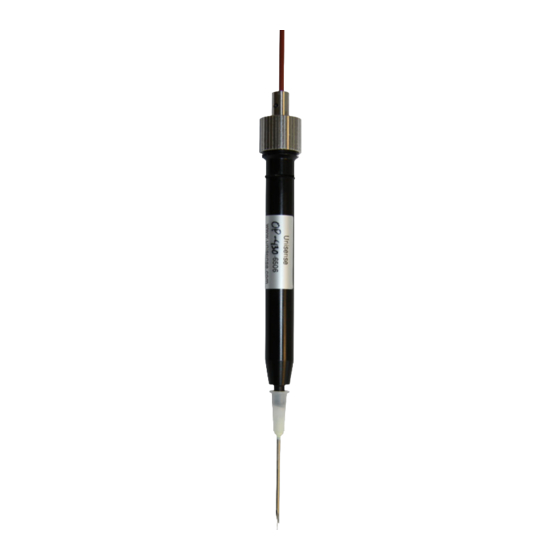
Table of Contents
Advertisement
Quick Links
Advertisement
Table of Contents

Summary of Contents for UNISENSE OXYGEN MICROOPTODE
- Page 1 OXYGEN MICROOPTODE USER MANUAL...
- Page 2 Manual Copyright © 2013 · Unisense A/S Version August 2013...
- Page 3 OXYGEN MICROOPTODE USER MANUAL UNISENSE A/S...
-
Page 5: Table Of Contents
TABLE OF CONTENTS WARRANTY AND LIABILITY . . . . . . . . . . . . . . . . . . . . . . . . . . . . . . . . . . . . . . . . . . . . . . . . . . . 4 CONGRATULATIONS WITH YOUR NEW PRODUCT! . -
Page 6: Warranty And Liability
The warranty does not include repair or replacement necessitated by accident, neglect, misuse, unauthorized repair, or modification of the product . In no event will Unisense A/S be liable for any direct, indirect, consequential or incidental damages, including lost profits, or for any claim by any third party, arising out of the use, the results of use, or the inability to use this product . -
Page 7: Congratulations With Your New Product
• The white seal is still intact • The MicroOptodes are returned to Unisense for inspection within two weeks • The MicroOptodes are correctly packed for return to Unisense, in accordance with the note included in the MicroOptode shipping box. - Page 8 RECOMMENDED METERS Unisense MicroOptode Meter...
-
Page 9: Overview
OVERVIEW WARNING Unisense MicroOptodes are neither intended This manual covers all the Unisense MicroOptodes . The nor approved for MicroOptode relies on the latest developments within optical fiber use on humans technology utilizing near infrared dyes for improved performance, high precision, high reliability, low cross-interference and fast response times . -
Page 10: Getting Started
Remember that a temperature sensor is required for correct oxygen measurements unless the measurement and calibration is completed at stable temperature . xygen Saturated Solution Place the MicroOptode in a well-aerated calibration solution (e .g . by bubbling with air in the Unisense calibration chamber) . - Page 11 100% oxygen saturation at atmospheric partial pressure . Zero reading ero reading An anoxic solution can be prepared in one of several ways; below we describe two methods recommended by Unisense: 1 . Prepare a solution of sodium ascorbate and NaOH, both to final concentrations of IMPORTANT 0 .1M (~2 g sodium ascorbate in 100 ml of...
- Page 12 . We CALIBRATION recommend the Unisense calibration As oxygen MicroOptodes chamber CAL300 . Place the MicroOptode in respond linearly to the anoxic solution, read the signal and add changes in oxygen the point to the software calibration .
-
Page 13: Measurements
. ounting of the icro ptode When the optical fiber is exposed Unisense recommends mounting the MicroOptode in a stabilized setup using the Unisense lab stand (LS18) and micromanipulator (MM33, MM33-2) to avoid damages on the MicroOptode . -
Page 14: I Nterference
nterference The oxygen sensitive dye on the optic fiber shows excellent brightness and their red light excitation significantly reduces stress in biological systems and interferences caused by autofluores- cence . The MicroOptodes can be applied in gas phases, aqueous solutions, ethanol, methanol and isopropanol . Other organic solvents and gaseous chlorine (Cl ) induce interferences with the sensor reading . -
Page 15: Storage And Maintenance
STORAGE AND MAINTENANCE tOrage Store the sensor in the protective plastic tube used for shipping, and store it in a dry, dark and secure place leaning the sensOr All oxygen MicroOptodes can be cleaned with peroxide (3% H soap solution or ethanol and can furthermore be sterilized with ethylene oxide (EtO) . - Page 16 MicroOptode Solution Darken the surroundings Problem Low signal Possible cause Broken tip Solution Replace the MicroOptode If you encounter other problems and need scientific/technical assistance, please contact sales@unisense.com for online support (we will answer you within one workday)
-
Page 17: Appendix: Equilibrium O 2 Concentrations
APPENDIX: EQUILIBRIUM O CONCENTRATIONS Detailed tables are available at our web page http://www.unisense.com/support/tables.html At 20 C and 1 atm.: 1 µmol O /l = 0.032 mg O /l = 0.024 ml O Table 1. Equilibrium concentrations of oxygen (µmol O /litre) at ambient partial pressure of 0.21 atm. - Page 20 UNISENSE, DENMARK www .unisense .com · info@unisense .com...

Need help?
Do you have a question about the OXYGEN MICROOPTODE and is the answer not in the manual?
Questions and answers